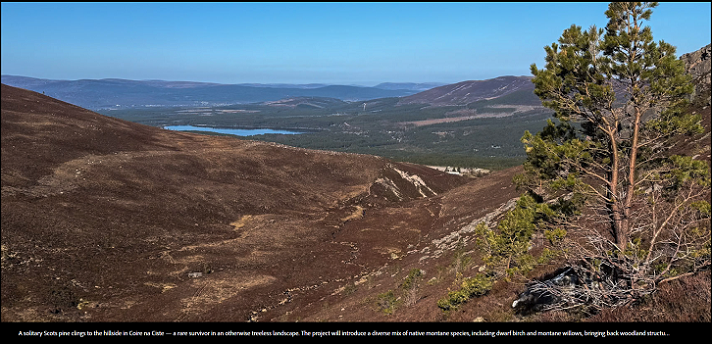
The caption reads “A solitary pine clings to the hillside in Coire na Ciste. A rare survivor in an otherwise treeless landscape”. Propaganda credit Spey Catchment IniitiatveA month ago, on 15th April, the Spey Catchment Initiative (SCI), a Scottish Charitable Incorporated Organisation (SCIO), formed in December 2022 issued a news release announcing it was to plant 30,000 trees in the upper parts of Coire na Ciste on Cairn Gorm (see here). This project, intended to make a major landscape change in the northern corries of the Cairngorms, was subject to zero public consultation, unlike almost every other forestry planting project in Scotland.
The caption to the photo above is false on three counts: the pine is not solitary, as is obvious from the photo; the pine is not a survivor but a relatively young tree that has colonised the coire – most probably from the Caledonian Pinewood in Glenmore below; and the landscape is not “otherwise treeless” but increasingly covered with trees as the Caledonian Forest naturally regenerates up the hill.
Chris Townsend explained this in an excellent blog post soon after the news emerged (see here) : “natural regeneration is always preferable to planting and it’s flourishing in Coire na Ciste. Spending time and money planting trees here would be a waste of time and money and could well disturb the trees already there. The forest should be left to grow and expand at its own rate and in its own time.”
The SCI’s claims about their plan to plant Coire na Ciste
Almost all the captions to the photos accompanying SCI’s news release (currently still available for viewing here) continue in the same vein. For example:
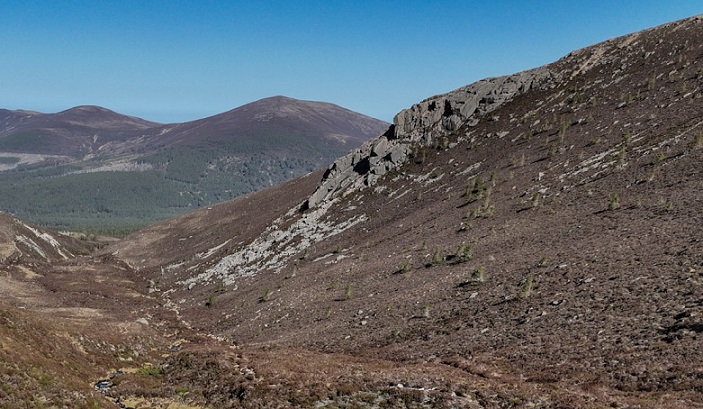
Treeless?
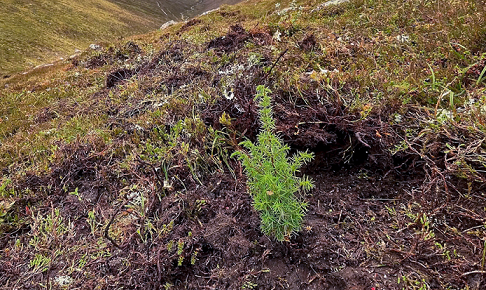
Montane willow and birch? Upright specimens of juniper such as this are more like those found in garden centres than the prostrate trees found on exposed slopes in the mountains.
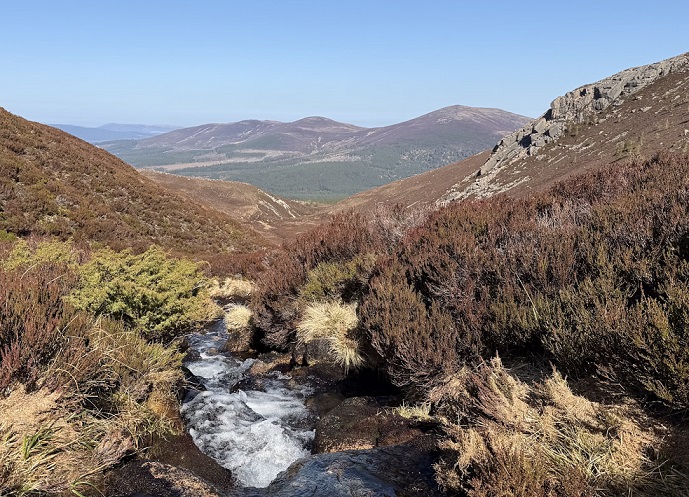
SCI’s “treeless slopes” claim is repeated several times in the captions despite the evidence clearly visible in their photos – in the one above besides the juniper (classed as a tree) Scots Pine are clearly visible on the slopes top right.
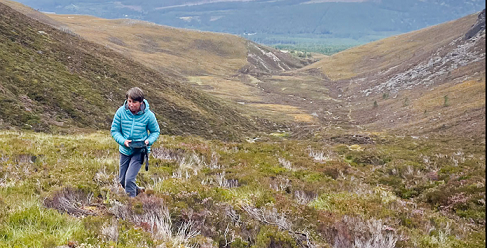
Planting trees is not natural recovery but a form of gardening. SCI’s photo actually shows what natural recovery looks like and it has been happening, contrary to their claims, for some time. Most of “the planting site” is covered in heather, an indication of low grazing pressure, and the bleached stems show some of it has reached the end of its natural life (c24 years). As heather dies this creates spaces where it is easier for trees to regenerate.
In summary, SCI’s photos accompanying their news release show a wilful disregard for the truth and have been used to try and deceive the public about the state of nature in Coire na Ciste.
The minutes of the Coire na Ciste montane woodland meeting of 20th November 2024 (see here) “Agreed that all publicity material, social media posts, etc will be signed off by all three partners [i.e Cairngorm Mountain Scotland Ltd and the Cairngorm National Park Authority (CNPA)] before release.” If that never happened, the CNPA needs to explain why, but if did sign off the materials it now needs to issue a public apology. Whatever the case it must now withdraw funding from the project before the tree planting is due to start in August.
Why planting Coire na Ciste is wrong
In a letter to the Strathy Dave Morris explained the strategic reasons why planting Coire na Ciste was a bad idea and why any planting on Cairn Gorm should be confined to Coire Cas:

I will not repeat Dave’s arguments here but the specific justifications the SCI has given for planting Coire na Ciste and its implications deserve more critical scrutiny. What follows is based not just on the claims SCI made in their news release (which lacked any maps or supporting information) but a copy of the full proposal, a minute of a meeting (link above) and a copy of a soil survey which has been supplied by the CNPA in response to a Freedom of Information request.

There is already extensive natural regeneration in the area proposed for planting, particularly on the east bank of the Allt na Ciste. As the Soil Survey Report, written by Andy Kennedy states:
“It appears that regeneration of native species is already occurring and if low grazing pressure is maintained, it is likely in time, that the whole area will regenerate without any additional input.”
It is a mystery why despite this evidence the SCI, CNPA and CMSL decided to go ahead with the planting anyway. The project document sets out the following Objectives (justifications) for the planting:
1) Expand the area and altitudinal limit of montane woodland and scrub
Comment: The soil survey notes that “Regeneration is limited at the higher elevations” proposed for planting and “only Rowan and Juniper were found”. In other words some tree species are already growing up to the altitudinal limits for the planting! No evidence is provided that more won’t do so with time through natural regeneration.
2) Increase the diversity of suitable tree and shrub species
Comment: Having discovered rowan were already on site, the proposal was restricted to “planting low-growing, hardy trees such as dwarf birch, downy birch, and montane willows—all adapted to life above 600 metres”:

Comment: at least half those species, to my knowledge, along with others (I have photos of aspen) are already on site. Both downy birch and eared willow are ten a penny trees that readily colonise new ground and there is no justification for planting them.
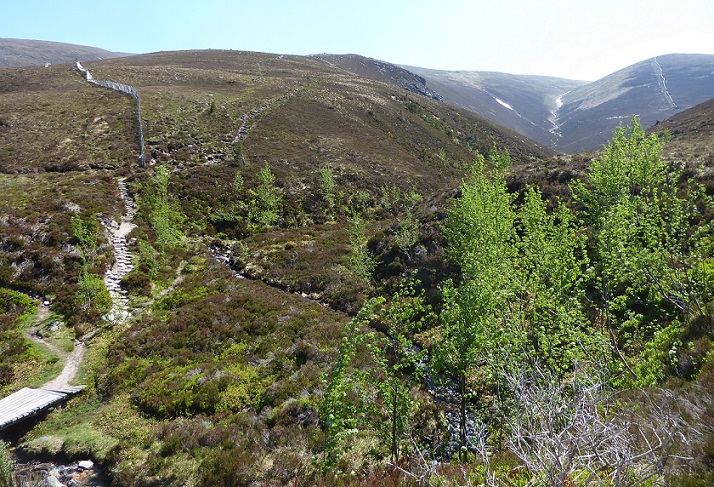
As for the other species, in the absence of information in the project documents, that requires checking but I have heard from someone with expertise in the vegetation of Cairn Gorm that there are no records of Dwarf Birch (Betula Nana) having grown in the area. That is perfectly natural, not every tree species was once found everywhere. However, Objective 3 (below) suggests the other willows are already found in Coire na Ciste If not, willow seeds carry in the wind and it would only be a matter of time before they too colonised the area.
3) Provide an additional seed source for further natural regeneration
Comment: With individual birches and willows producing hundreds and sometimes thousands of seeds you don’t need to plant 30,000 trees, as SCI and the CNPA are proposing, to create an additional seed source.
4) Build a habitat corridor to higher altitudes for other woodland species
Comment: the meeting minute shows the CNPA were to “contact RBGE (Royal Botanical Gardens Edinburgh0 to find out if they are interested in the site for possible planting of rare montane vascular plants”. If the CNPA want to do that they would be better expanding the Alpine garden above the day lodge in Coire Cas which has been sadly neglected by CMSL.
5) Provide shading to the Allt na Ciste to control rising water temperatures
Comment: This objective, repeated in the news release, is complete and utter nonsense. The Allt na Ciste runs almost due north, traps snow and due to the topography is already shaded for much of the year. As SCI’s photos show, the vegetation along its banks is already quite dense, providing further shade, and planting dwarf birch and willows will not make any difference to that. The hydrology of the burn makes further nonsense of the claim. The Allt na Ciste is steep and fast flowing, so there is little time for the water flowing down it to heat up even in direct sun. It is also just one of dozens of other tributaries feeding the Spey and contributes a tiny percentage of its total flow so just what the SCI think shading it further will do to the temperature of that river is unclear.
6)Reduce runoff rates to retain rainfall & snowmelt for longer contributing to flood & drought resilience
Comment: the news release also comments the planting will help stop erosion although almost all the bare rock and soil in Coire na Ciste are ABOVE the area to be planted and sparsely vegetated soils are a natural feature of the plateau. Most of the area proposed for planting is already well vegetated with heather or covered in peat (as per the map below) and both of already function to retain rainfall and snow melt.
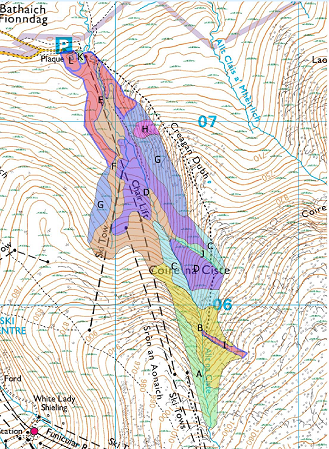
SCI has provided no eviddence to support the claim yhat planting trees in this location will make any appreciable difference.
Ironically, having approved the planning proposals for various developments in Coire Cas which will increase the rate of water run-off into the Allt Mhor which been responsible for serious flood damage in the past (the smoothed beginners area for example (see here)) the CNPA now wants to tinker with a relatively minor tributary of the Spey which is in a much better ecological state.
7) Trial montane woodland planting methods and act as a demonstration site for similar projects
Comment: If the SCI wants to do this they would be far better doing so in Coire Cas
8) Enhance landscape diversity and visual amenity for recreational visitors
Comment: If the CNPA wanted to improve the landscape of Coire na Ciste, it could start by demanding HIE/CMSL do up the building by the car park and also get it to remove all the hardstanding left by the demolition of the lift towers (see here). It would then leave the rest to nature.
The planting proposal & outdoor recreation
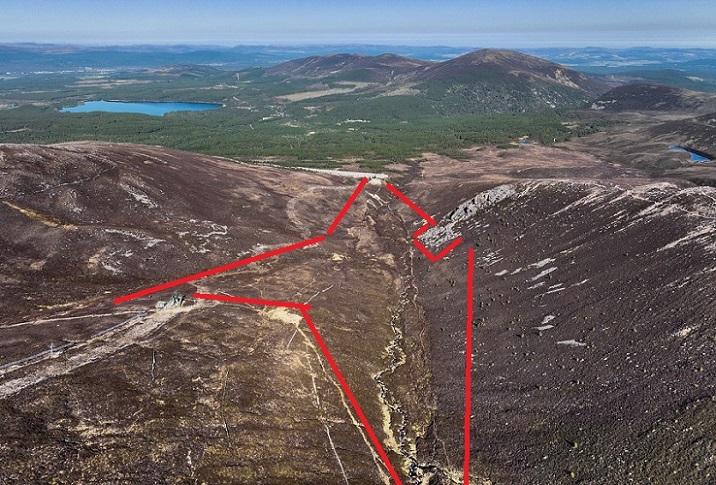
No consideration is given in the plans to the impact of the planting on outdoor recreation or vice versa.
The map shows that the planting will skirt the lowest remaining ski tow and run just below the traverse line used by downhill skiers and boarders to return to the tow from the Allt na Ciste. However, this takes no account of the fact that when snow conditions are good the groind below the Ciste tow is used by both piste and touring skiers and boarders to descend to the Ciste car park. Much of the west side of the Ciste has boggy ground, with a lot of peaty soil (as shown in the soil survey) so it naturally it will have few trees and lots of open ground, excellent for snowsports and definitely NOT a place to plant trees!.

The proposal document, dated November 2024, refers to “Full consultation with CMSL and walking/skiing bodies. Avoid planting near main access routes” It is unclear if that ever happened or whether the CNPA ever consulted their access team. Had anyone asked Mountaineering Scotland, who represent ski tourers, about the proposal I am fairly confident they would have highlighted the trees will be planted right across the lines most likely to be taken by skiers and boarders in the lower coire. This will clearly have a significant impact on the survival rates of any trees planted there.
The planting, however, provides the perfect excuse for HIE/CMSL to run down what remains of the lift infrastructure in Coire na Ciste still further, in a desperate attempt to force people to use the funicular and despite the fact it holds snow much better than Coire Cas.
What needs to happen?
As Dave Morris argued, the one place where planting trees would be justified at Cairn Gorm is in Coire Cas. That Coire is in a sorry mess visually and it’s soils have been moved and compacted time after time due to engineering works and vehicles being driven willy nilly across the site. That has greatly increased the likelihood of catastrophic flooding and landslips. Planting trees in Coire Cas could therefore help avert disaster and mitigate some of the worst landscape impacts of the ski development. Trees would also help to trap/retain the snow like snow fences.
Given CMSL and the CNPA are partners in this project, they now need to explain why they have chosen Coire na Ciste, where nature is doing very well, in preference to Coire Cas for this “conservation” project. By far the best option now would be for the CNPA to transfer the whole planting project to the Cas. It is unlikely anyone, apart possibly from HIE/CMSL, would object and doing so would avoid wasting any trees earmarked for the project. This would be easy enough to do because the project was developed without the involvement of Scottish Forestry and the CNPA holds all the power as it is providing the funding.

And we need to emphasise that the northern corries of the Cairngorms are probably the best places in the UK to observe the re-establishment of woodland, up to the altitudinal limits for tree growth, by natural regeneration. This has been recognised for over 50 years as the ancient Caledonian Forest of Glenmore began to expand uphill as deer grazing pressures were reduced. Protecting this natural expansion is a vital part of Caledonian pinewood conservation. The SCI’s ignorance of this key policy is extraordinary and appears to underlie their reckless attempts to plant in the wrong corrie.
And we need some questions directed towards the CNPA. This is the second time in recent years when its actions have been seriously detrimental to the enjoyment and development of snowsports. Prior to this fiasco in the Ciste the CNPA failed to stop BrewDog planting and fencing the best slopes to the west of Aviemore for ski touring, to the north of the Burma Road. It also needs to review its relationship with the SCI, its near neighbours in Grantown-on-Spey. Earlier this year crofters and farmers in the strath expressed their fury at a meeting in Laggan at a report by the SCI, funded by the CNPA, which proposed significant changes to the flood defences on the upper River Spey. Now we have the CNPA wasting more public money on an SCI inspired project on Cairn Gorm. It is time for the Scottish Government to ask some searching questions about the CNPA’s budget and its relationship to the SCI.
I dont know anything about this project, but taking your criticisms at face value, compare and contrast with the JMT proposals to fence Schiehallion. Well meaning but ill thought out schemes taken forwards by public/ NGO organizations, not going through the Forestry Grant scheme, therefore side stepping the usual checks and balances, usual consultees (MCoS/ Ramblers etc) not wanting to say anything/ not in evidence, hyped PR stories out of all proportion with the actual ecological potential of the project, no public consultation process whatsoever, therefore no means of picking up on obvious problems. There is a case for planting if regeneration is only going to happy very slowly, but as you say, there is clearly woodland shown in the photos that contradicts much of the official story. I would be very happy to do a recorded Zoom interview which you could use on this website….. the subject being inappropriate native woodlands schemes, and what motivates people who should know better to participate in them. I think that might get some hits!! We wont have exactly the same views, and may disagree on some points, but there is a theme here, and we need to air what that means and why it is a problem.
We need to understand how approval was given for the funding of this project – it’s all public money after all. Did the HIE Board and the CNPA Board approve the funding? If not, who approved the spend in these two public bodies? If this issue was not discussed at a CNPA Board Meeting, then the matter needs to be raised by a CNPA Board Member as a matter of urgency, quoting this blog as reasons for asking for a full review of the decision and also asking why there was no public consultation on the project.
HIE and CNPA too readily forget that they are accountable to the public for spending our money
Hello all, thanks for this site and its commetary on the “developments” in the Highland counrtyside. May I ask that every so often you publish a glossary of abbreviations so we know the name. Keep the articles and comments coming.
Hi Michael, I normally try to spell out full names in posts before using abbreviations but don’t always explain what the full term means – I will try and do so more, Nick
Mother Fuckin Split board community reporting in. Plant those trees.
Also as a side note I don’t understand the hostility towards every attempt to make Scotland more bio diverse then a parking lot. I never thought something like beaver reintroduction would be controversial. But here we are.
I’ve never met so many so proud of so little, and so hell bent on keeping it devoid of life.
When your not getting stiffies over the highland clearances or boasting about lizard moon rulers look up trees influence on slab stability. Snow sense is a good place to start.
You’ll probably get triggered by the photos of more intact/natural ecosystems. Don’t worry with your continuous spread of misinformation that 18.5% coverage will be 0% in no time!
Sincerely
Boner Mountain Splitboarders Association
I have no hostility to Scotland becoming more nature diverse – as explained that has been happening in Coire na Ciste – and its far from devoid of life, for example its one of the places bird guides takes their clients to see Ring Ouzel. So why do you think human interference is better than letting nature do the job? The evidence for the Cairngorms (Far Ralia, Mucktrach, BrewDog etc) is that planting has far from making ecosystems more diverse helped destroy them. Where I do think native tree planting is justified is in places subject to landslips, like the Rest and Be Thankful, but there is no evidence that this is an issue in Coire na Ciste